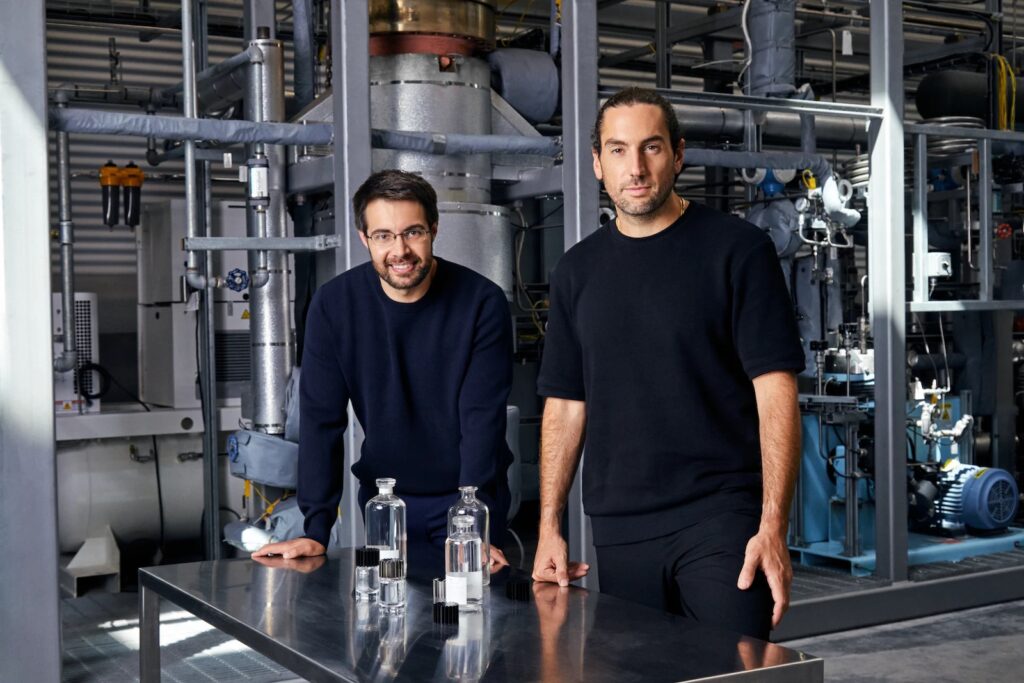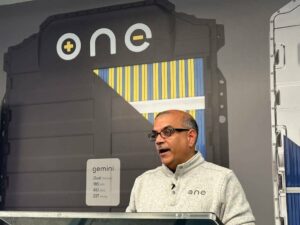
Carbon dioxide, the most readily available greenhouse gas, is being examined by multiple organizations as a fuel source.
The Department of Defense, the U.S. Air Force, the Operational Energy Capability Improvement Fund, the Department of Energy and the Army’s chief engineers office are looking at the gas as a way to fuel military aircraft during times of war. They’re all expanding experiments that use pollution as a source of fuel.
The Pentagon’s Defense Innovation Unit has awarded a contract to Air Company of New York City to transform the atmosphere’s most abundant pollutant into synthetic aviation fuel in a $65 million contract. The agreement is part of Project SynCE — Synthetic Fuels for the Contested Environment.
“We have an incredible opportunity to reduce our burden on global energy supply chains, and simultaneously reduce emissions, without sacrificing mission effectiveness,” said USAF Lieutenant Colonel Nicole Pearl, Project SynCE operational lead. “By developing and deploying on-site fuel production technology, our Joint Force will be more resilient and sustainable. Together with the DoE and the commercial industry, we’re working towards revolutionary energy solutions that benefit not just the military, but our society as a whole.”
Why it’s needed

According to the Pentagon Logistics Agency, the Defense Department will spend more than $11 billion on fuel in fiscal 2022, making it the government’s largest user, with military aircraft consuming the most.
The DoD must employ a variety of ships, tanker planes, and convoys to keep rolling. The networks and their logistics are both time- and cost-intensive, and are extremely vulnerable to disruption. Then there’s the matter of the pollution it causes.
The DoD is looking for a solution that can be highly mobile or produced in fixed locations, and can be supplied anywhere using sustainable air or sea water. This not only ensures mission flexibility, but it will help reduce greenhouse gas emissions compared to conventional jet fuel. And the resulting fuel doesn’t have to be mixed with fossil fuel to work. This frees the DoD from depending on potentially hostile nations to fuel its aircraft.
Air Company’s method mimics photosynthesis, converting carbon dioxide into Sustainable Aviation Fuel, or SAF, that is carbon-negative in its production. Air Company first demonstrated its carbon capture technology by making vodka and perfume. Air Company secured $30 million in funding in April 2022 with help from Carbon Direct Capital Management, Toyota Ventures, JetBlue Technology Ventures and Parley for the Oceans.
Not alone in its efforts
But Air Company isn’t the only firm pursuing the promise of synthetic fuel.

In Japan, the Toyota Corolla and GR86, Mazda Demio and Subaru BRZ, all of which burn synthetic fuel, are competing in the Super Taikyu road race series in the ST-Q class, one meant for cars that use experimental technology. And Formula 1 has promised to use synthetic sustainable fuel as soon as 2026.
Meanwhile, Porsche has partnered with Chilean-based company Highly Innovative Fuels (HIF), in which Porsche has invested $75 million for a 12.5% stake, to produce synthetic fuel made from water and carbon dioxide using wind energy to enable carbon-neutral operation of internal combustion engines.
Pilot phase production began in December 2022, with the plant initially producing 34,342 gallons (130,000 liters) annually. By 2025, Porsche is looking for the plant to produce 14.53 million gallons (55 million liters) per year, growing to 145.3 million gallons (550 million liters) by 2027. But its cost remains high, as the plant can produce eFuels for about $2 a liter, or $7.60 per gallon. Porsche will be the first to purchase the eFuel, utilizing it to power vehicles at the company’s “Experience Centers” as well as for racing.
“The potential of eFuels is huge. There are currently more than 1.3 billion vehicles with combustion engines worldwide. Many of these will be on the roads for decades to come, and eFuels offer the owners of existing cars a nearly carbon-neutral alternative,” said Michael Steiner, Executive Board member for Development and Research at Porsche AG.
Whatever happens at automakers, the DoD’s interest is sure to spark further development of turning carbon dioxide back into fuel, as military projects often lead to consumer market innovations.
Just ask a Jeep Wrangler or Hummer H2 owner.
- SEO Powered Content & PR Distribution. Get Amplified Today.
- Platoblockchain. Web3 Metaverse Intelligence. Knowledge Amplified. Access Here.
- Source: https://www.thedetroitbureau.com/2023/03/groups-examine-producing-fuel-from-greenhouse-gases/
- :is
- $65 million
- 000
- 1
- 1.3
- 2022
- a
- About
- AG
- agency
- Agreement
- AIR
- Air Force
- aircraft
- All
- alone
- alternative
- and
- Annually
- anywhere
- April
- ARE
- AS
- At
- automakers
- available
- aviation
- awarded
- back
- BE
- began
- being
- benefit
- Billion
- board
- board member
- BRZ
- burden
- burn
- by
- CAN
- capital
- capture
- carbon
- carbon capture
- carbon dioxide
- cars
- causes
- ceo
- chains
- chief
- class
- co-founders
- come
- commercial
- company
- Company’s
- compared
- competing
- consumer
- contract
- conventional
- Cost
- CTO
- Currently
- decades
- December
- Defense
- Defense Department
- demonstrated
- Department
- department of defense
- Department of Energy
- Depending
- deploying
- developing
- Development
- direct
- Disruption
- disruptions
- DoD
- DOE
- Doesn’t
- during
- effectiveness
- Emissions
- enable
- energy
- Energy Solutions
- Engineers
- Engines
- ensures
- Environment
- executive
- existing
- expanding
- extremely
- Firm
- First
- Fiscal
- fixed
- Flexibility
- For
- Force
- formula
- Formula 1
- Fossil fuel
- from
- Fuel
- fuels
- fund
- funding
- further
- further development
- GAS
- Global
- greenhouse gas
- Greenhouse gas emissions
- Group’s
- Growing
- happens
- Have
- help
- High
- highly
- HTTPS
- huge
- improvement
- in
- incredible
- industry
- initially
- Innovation
- innovations
- innovative
- interest
- internal
- invested
- IT
- ITS
- Japan
- jeep
- jetBlue
- joint
- jpg
- Keep
- largest
- lead
- locations
- logistics
- looking
- made
- Making
- management
- many
- Market
- Matter
- max-width
- member
- method
- Michael
- Military
- million
- Mission
- mixed
- Mobile
- more
- most
- multiple
- Nations
- nearly
- networks
- New
- New York
- oceans
- of
- offer
- Office
- on
- ONE
- operation
- operational
- Opportunity
- organizations
- own
- owner
- owners
- part
- partnered
- Partnership
- pentagon
- Perfume
- phase
- Photosynthesis
- Planes
- plato
- Plato Data Intelligence
- PlatoData
- Pollution
- Porsche
- potential
- potentially
- power
- prevent
- produce
- Produced
- Production
- project
- projects
- promise
- promised
- purchase
- Race
- racing
- reduce
- remains
- research
- resilient
- resulting
- revolutionary
- road
- roads
- Rolling
- s
- sacrificing
- Said
- SEA
- Secured
- Series
- ships
- simultaneously
- Society
- solution
- Solutions
- Soon
- Source
- Spark
- spend
- stake
- Super
- supplied
- supply
- Supply chains
- sustainable
- sustainable aviation fuel
- synthetic
- Technology
- that
- The
- their
- These
- times
- to
- together
- towards
- toyota
- Transform
- Turning
- u.s.
- U.S. Air Force
- unit
- use
- User
- Utilizing
- variety
- Vehicles
- Ventures
- Vulnerable
- war
- Water
- Way..
- WELL
- which
- will
- wind
- wind energy
- with
- without
- Work
- working
- worldwide
- year
- zephyrnet












